I love the older starch-filled buckrams you find in the stacks. You can drive a truck over it but you can’t destroy it. Unless you are mold hyphae. Then it is nothing more than a delicious snack.

You know the feeling when you get to work on a Monday intending to get stuff done because last week was one of those weeks? You get your tea, settle in, open your email…
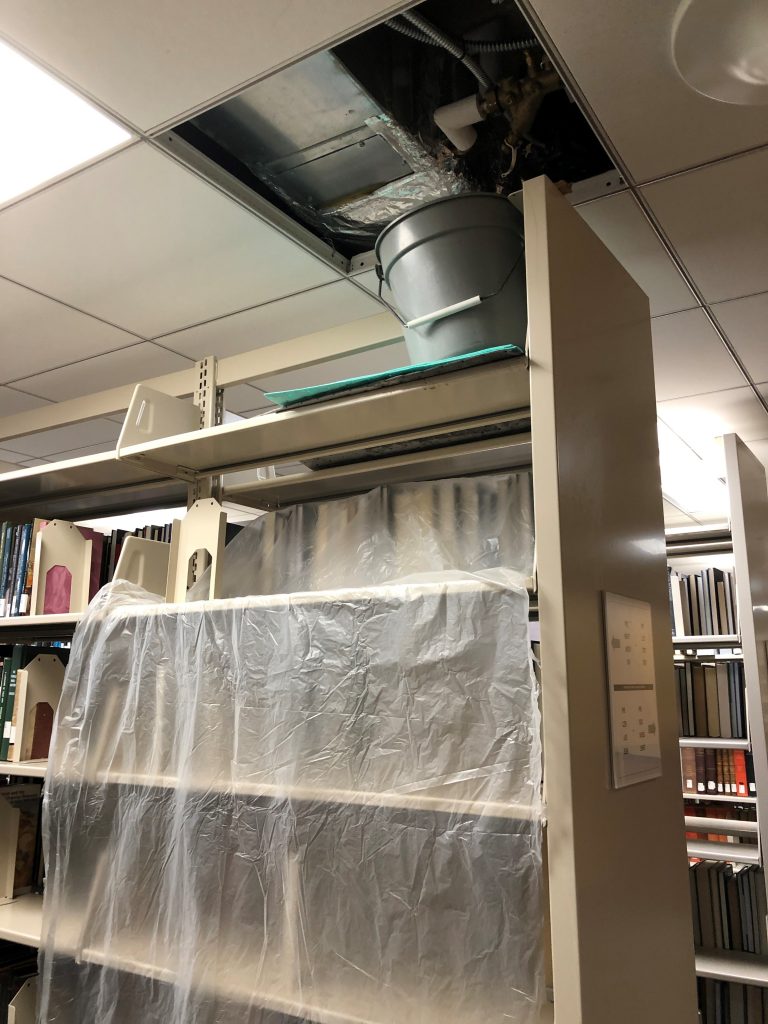
So much for that morning to-do list…

As disasters go we were lucky. This HVAC joint must have slow-dripped all weekend, or at least a portion of it. Some items were soaking wet, but most were damp or even dry.
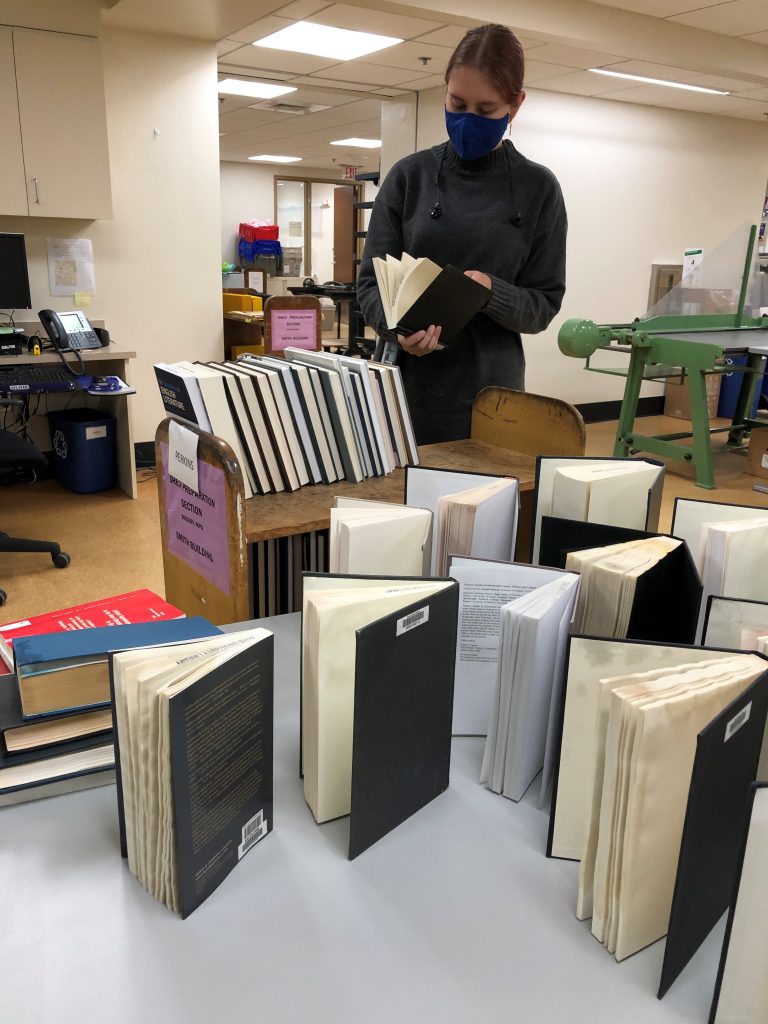
We removed 157 books from the shelf for evaluation, 23 were wet or damp. We were able to set out 18 of these to air dry in the fume hood (remember the wiggle!). Five went into the freezer.

The books in the fume hood were dry enough to put into the press on Tuesday. The items in the freezer will be monitored for the next few weeks. When they (and we) are ready to dry, we will get those done and back to the shelf.
Access and Delivery Services, Security and Facility Services, Stacks Maintenance and Retrieval, Duke Housekeeping, and Duke Facilities, all helped with this small water event. We appreciate having so many eyes and hands to help!
By Mary Yordy, Senior Conservation Technician
At the beginning of the quarantine, practical arrangements to retain connectivity to my desktop at work and forge other forms of digital connectivity with my workplace kept me busy. I researched questions about surface contamination of books and paper, I cleared out and organized files and reviewed hundreds of informative links and tutorials I’d neglected to study in my usual routine, wherein I’m juggling the day-to-day demands of my bench work against the influx of digital resources. But weeks became months, and I am used to seeing the results of a day’s work mounting up in the book press or filling shelves. Though I was diligent in my hours at home, after around six weeks I needed to produce something tangible, and I wanted it to be relevant to the life of the lab.
Work runs along a fulcrum from past to future that is understood collectively and concretely. Without that, it’s hard not to suspect we have become shadow boxers. How do we create assets for a post-epidemic future we cannot fully know? How do we make decisions about value and use without knowing what the future holds or when it will start? Luckily for me, the perfect project appeared under my fingertips late one night, going through my files at home: “Sewing Samples–2006.” Preserved within it were the beginnings of a project that related to the early history of the lab, one had the potential to provide knowledge to future workers in our craft.
The file held a collection of cards made during one of the early in-house workshops Beth Doyle taught for the three technicians on staff at the time: me, Rachel Ingold, and Diane Sutton. Beth taught us basic and more complex sewing methods, stitches and knots used in bookbinding. Recalling that day, sitting around an old library table in the 2006 lab, threw the impressive developmental span of Duke Library Conservation in sharp relief.

In addition to the samples sewn that day on index cards, there was a nearly complete set of the stitches sewn onto black paper folia in the folder. I had never completed this more advanced solo project based on Beth’s original workshop. The idea was to make something visually appealing, complete, and inclusive of additional visual information to orient a beginner to the application of the stitch in 3-dimensional structures.



Stitch sample cards made in the course of workshops work well as memory prompts for people who have already learned them. However, for beginners, the flattening of the sewing process onto a card and the need to infer structural information can make them a little baffling. I had come across this file once or twice before and verified that it was a worthy goal. But mid-quarantine, the project felt like more than that: it was like an arc from the beginnings of the lab, through this time of mass uncertainty, to the future gaze of someone beginning to learn bookbinding.

I finished sewing all of the samples on the face of black folia, located other visual information needed to design inserts for each folio, and built a gate-format accordion album in a hard case to hold them all. There are 8 spaces on the back of the fold outs so additional samples can be added–there are always more stitches to learn.

Like many other libraries we are pushing to get as much material digitized and online for fall term instruction as possible. Conservation, however, is not yet back on site but our services are still needed. I came in this week to work on some items that needed humidifying and flattening, and to do some quick repairs to get these camera ready.

This collection had a lot of rusty staples that needed removal.
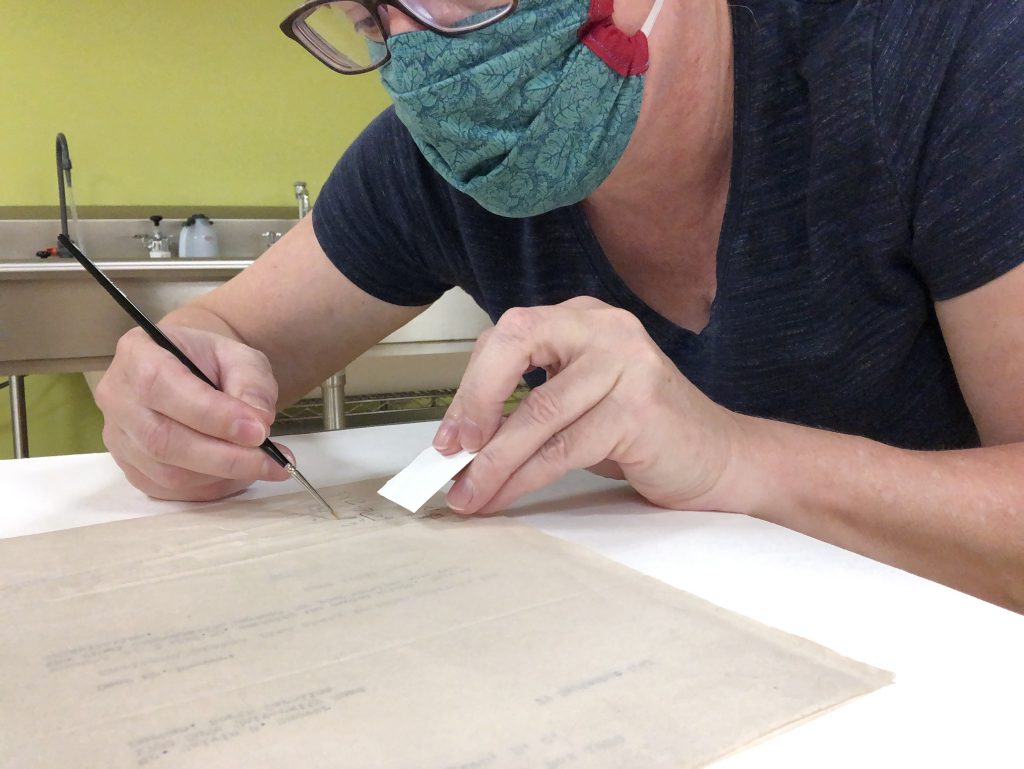
There are several Western Union telegrams and other correspondence that were crumpled and torn that are too fragile for imaging. These had a variety of media that looked suspect including early mimeographs, stamp ink, copy pencil, and other writing inks. These were tested prior to humidification.
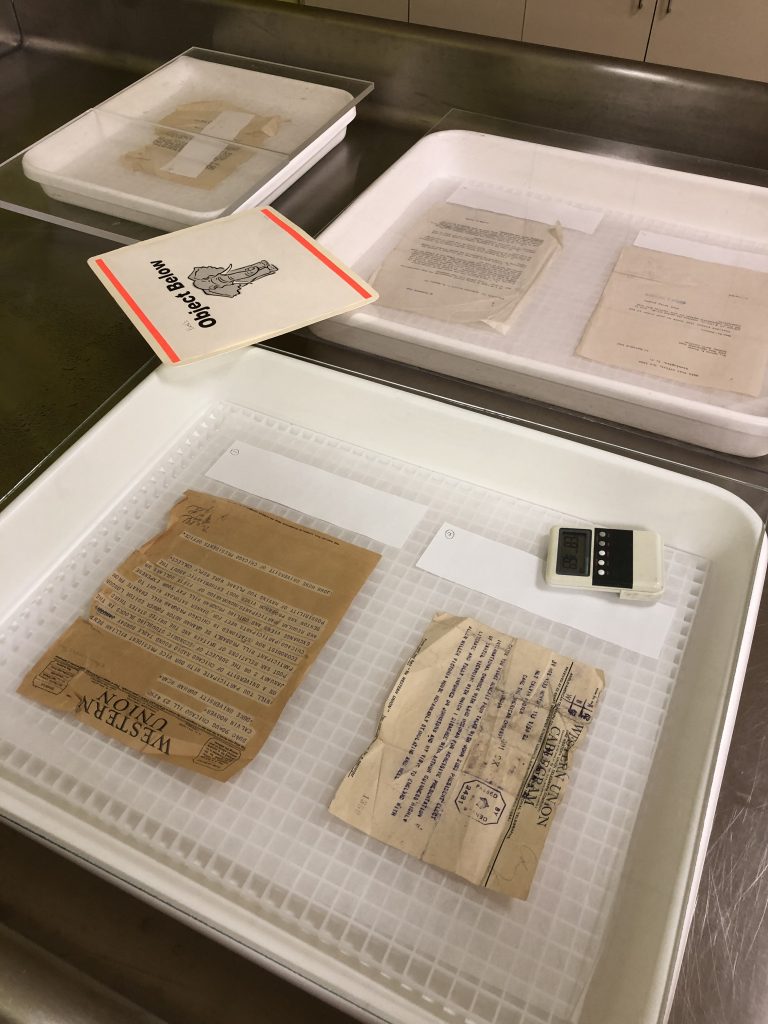
Even though the media was somewhat sensitive to water it felt OK to humidify these as long as I kept watch over them to make sure there was no media migration. I started with one telegram to see how it responded to humidification. When that went well the remaining items were put into the chamber for a few hours to relax. They were then dried under felts overnight.
Since these were very modern materials we decided to use our home-made heat set tissue for the repairs. These were stabilized and sent over to the Digital Production Center for imaging today.
It feels good to be working in the lab again, although a bit strange to be here with no one else around. Hopefully soon it will be safe enough to bring more of the Conservation staff back to the lab. Until then we will have to see each other in Zoom.

It’s #WorldBookDay today and we are highlighting some books that have come through recently from Technical Services.
There seems to be a new trend in publisher’s bindings: the exposed-spine binding. We call them “naked bindings” because they lack part of their cover. There’s even a subject heading for this kind of binding called “Backless Bindings (binding).”

There are a few things they have in common:
Variations include:
One commonality: these are very weak bindings especially those with tipped-on covers, loose sewing, and unevenly applied adhesive.
It feels like publishers and/or authors simply choose this style of binding because it feels edgy. But when this style of binding is chosen thoughtfully, it can really work. The best of this batch has to be “Hilos Libres: el textil y sus raíces prehispánicas, 1954-2017 = free threads : textile and its pre-Hispanic roots, 1954-2017” by Sheila Hicks. This books was, “Published on the occasion of the exhibition held at Museo Amparo, Puebla, from November 4th, 2017-April 2nd, 2018.”
Why does this binding work for this book? The book is about a textile exhibit. The exposed threads, multi-colored thread choice, and loose threads on the front cover all relate in some way to the textiles highlighted in the text block and textile artistry.



The covers are fully adhered to a doublure, and that section is sewn onto the textblock. This creates a very stable and secure cover attachment. Overall it is a solid binding whose design connects to the contents of the book.
These are obviously machine-sewn edition bindings but they hark back in my head to Coptic bindings with a nod towards the Sewn Board Binding originally designed by Gary Frost (which itself gives nod to Coptic bindings).

These exposed spine bindings lay really flat because they don’t have all those pesky spine linings to control the opening. They are very vulnerable to rough handling because the binding has no protection and the board attachment is really weak.
This group of “Backless bindings” will have custom four-flaps created to protect the bindings. If these were special collections items we might consider a “peekaboo” box that allows the spine to be seen on the shelf. But since these are in the circulating collections, we will give them a standard four-flap enclosure or corrugated clamshell box. These provide a bit more protection from handing and reduce light exposure.
Happy #worldbookday everybody!
By Mary Yordy, Senior Conservation Technician
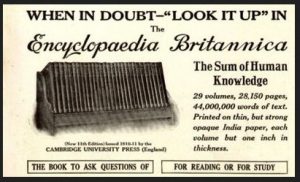
Unlike millions of old reference works in declining bindings, the 11th Edition of the Encyclopedia Britannica, published in 1910, has a following. Veneration of this edition of the Encyclopedia Britannica spans beyond libraries and the antiquarian book trade into popular culture. A. J. Jacobs writes about it in his book The Know-It-All, and Hans Koning, powerhouse of New Left thought, published an eloquent meditation on the world view reflected in its pages. It is discussed as THE GREAT 11th EDITION, listed alongside the works of Heidegger, Camus, and Fukuyama as one of the 100 most important non-fiction works of the 20th Century. Two websites are devoted to 11th Edition fandom. There is even a fingernail polish.
People who praise the 11th Edition Encyclopedia Britannica point to the illustriousness of the contributors, the profusion of beautifully written biographical entries with odd, sometimes questionable details (Pedro I of Portugal disinterred his dead mistress and placed her remains on the throne of the queen, Potemkin died “…in consequence of eating a whole goose in one sitting,” etc., etc…) or the detailed, illustrated accounts of manufactures, engineering, and natural history. But the veneration of this work is more diffuse and more adoring than these particularities account for. Hans Koning writes:
“The world of the Eleventh Edition was at the zenith of those ‘encyclopedic’ prerequisites, rationality and positivism. All of humanity appeared to be on the threshold of being totally understood, described, improved, and then perfected, through the logic of Anglo-American institutions and thought…it was the high point of the Enlightenment, doomed to end when the lamps went out all over Europe in the fatal summer of 1914.”
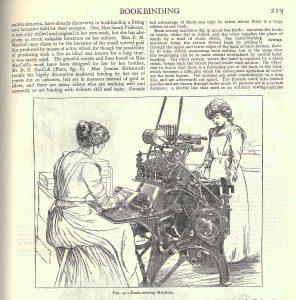
Kelly Lawton of Lilly Library had come across a single volume I repaired in the early 2000’s and asked Beth Doyle if it could be used as a model for repair of the remaining numbers in their original bindings. This repair had retained the section sewing and the boards but replaced the badly degraded leather spine and heavy, brittle end sheets. My goal had been to make it robust enough to be handled as part of the circulating collection without unduly sacrificing original components. Fortunately, the technician, the end sheet paper and the black book cloth involved in the process that produced that successful repair were still available to create a matched set.
Within the week a large bin arrived and the project began. I used a combination of poulticing and manual manipulation to remove the degraded leather on the spines and the pastedowns on the inside of the covers. This was perhaps the biggest mess I have ever made in the lab, and required a thorough cleaning of tools and work surfaces each night. There were piles of degraded leather crumbles and dust, globs and slurries of poultice, all haunted by the distinctive odor of old animal hide adhesive. Poultices had to be watched closely because some of the remaining leather glued to the back still contained green pigment that jeopardized the section backs of sheer white ‘India paper.’
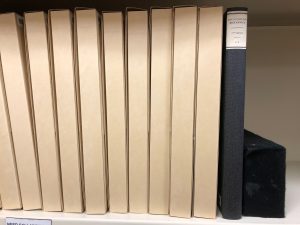

Once all 14 volumes were clean, backed and fitted with new end sheets, I reused the original embossed covers in a case structure and filled my press with the newly cased Encyclopedia Britannica volumes.
We regularly see book publishers’ attempts to set their products apart from the rest of the market here in the conservation lab – usually because the novel materials or structures they have chosen don’t hold up so well under normal use. We often find ourselves asking, “What will these publishers try next?” This week the answer to that question came in the form of robots.
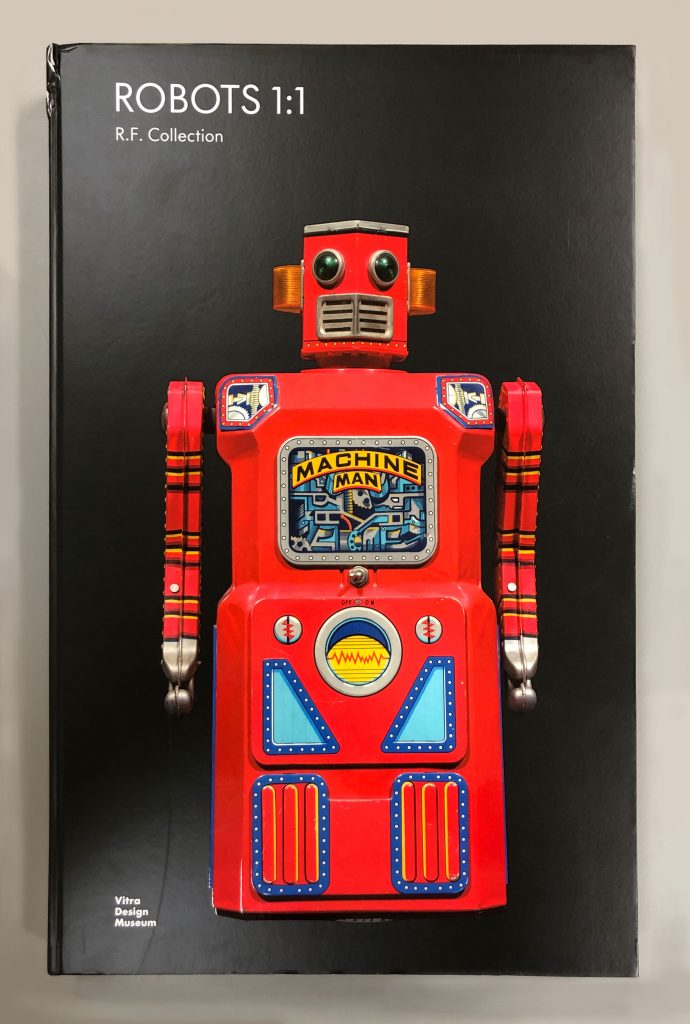
This very large and weighty volume depicts over 100 space-themed toys held by the Vitra Design Museum. Much like our copies of Audubon’s Birds of America, the book is so large because the toys and their original packaging have been photographed and printed at a scale of 1:1. And I will say the images are wonderful.
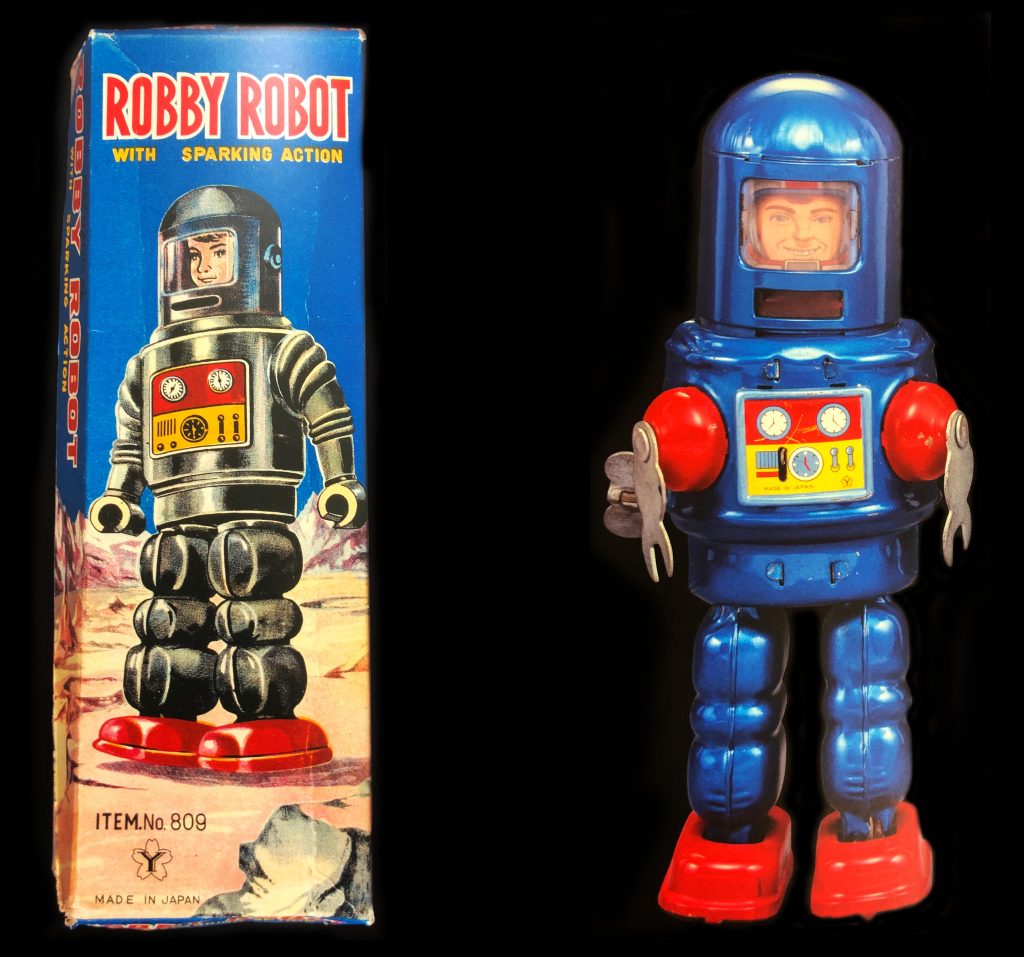 The unique feature of this book, however, is a USB memory stick that has been integrated into the headcap. The stick contains a film by Luka Dogan, showing a selection of the robots in action.
The unique feature of this book, however, is a USB memory stick that has been integrated into the headcap. The stick contains a film by Luka Dogan, showing a selection of the robots in action.
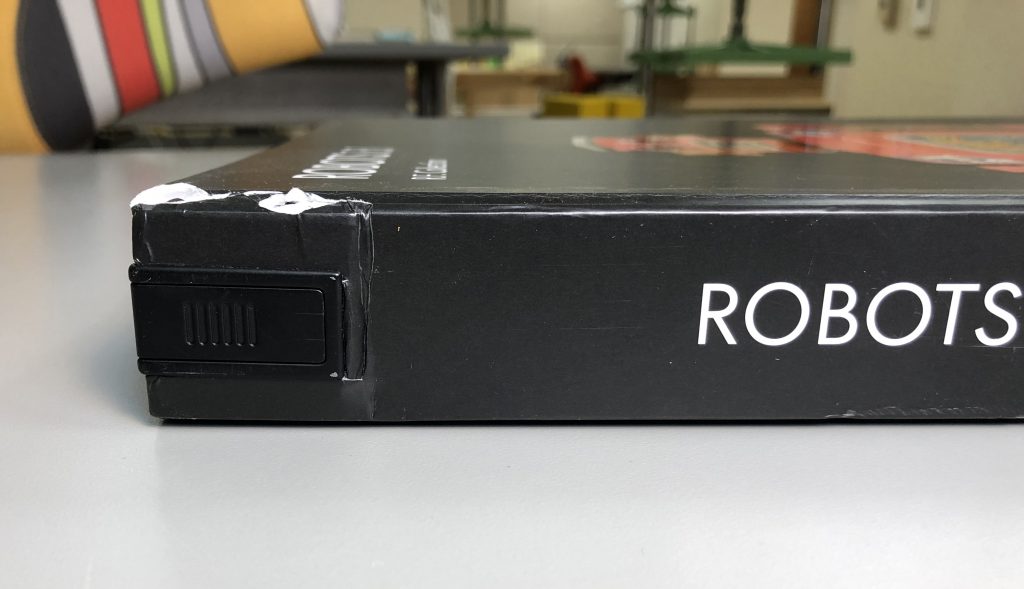 We often see volumes with additional media included, usually as a CD or DVD inside a paper or plastic pocket that has been adhered inside one of the boards. Other types of media are too thick to be handled in the same way, so the location of this USB and it’s “holster” are interesting and unobtrusive. It includes some nice design elements, like a small magnet to hold the stick securely in place.
We often see volumes with additional media included, usually as a CD or DVD inside a paper or plastic pocket that has been adhered inside one of the boards. Other types of media are too thick to be handled in the same way, so the location of this USB and it’s “holster” are interesting and unobtrusive. It includes some nice design elements, like a small magnet to hold the stick securely in place.
The problem comes when you actually try to get the stick out. Grasping the stick and pulling it free puts a lot of stress on the headcap and joints, some of the weakest areas of the binding. As you can see, the front joint has already started to tear. Additionally, the glue holding the metal USB holster in place has failed and it now easily slides out from the spine piece.
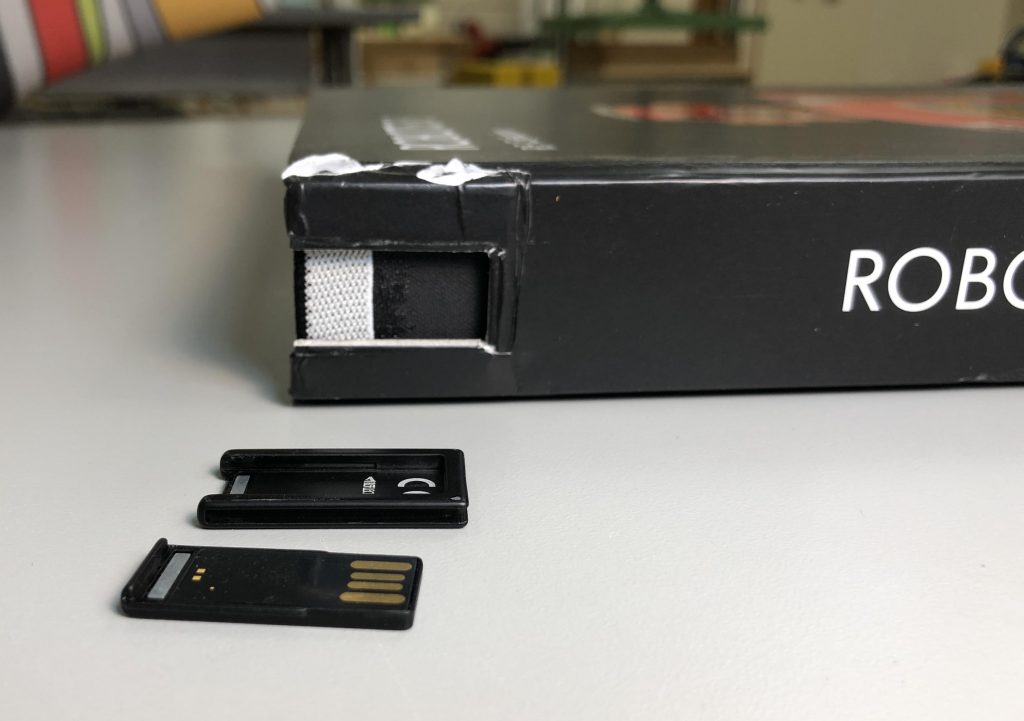 Including additional media with a publication can provide a lot of additional value to the reader. It also means loose components can easily become lost. As technology ages, it can be a challenge for readers to actually use the media. For example, the laptop I’m using to write this post doesn’t have a disk drive of any kind, so reading a CD or DVD would be a problem. I guess it’s only a matter of time before a USB Type-A port becomes scarce as well. The added media might become less accessible, but at least you don’t need a machine to read the book!
Including additional media with a publication can provide a lot of additional value to the reader. It also means loose components can easily become lost. As technology ages, it can be a challenge for readers to actually use the media. For example, the laptop I’m using to write this post doesn’t have a disk drive of any kind, so reading a CD or DVD would be a problem. I guess it’s only a matter of time before a USB Type-A port becomes scarce as well. The added media might become less accessible, but at least you don’t need a machine to read the book!
It’s that time of year when we report our annual statistics to our administration. We thought we would share these with you, too.
839 Book Repairs (down 23% from last year)
1,439 Pamphlets (up 35%)
12 Treatments: Other (not reported last year)
2,434 Flat Paper (up 75%)
6,822 Protective Enclosures (up 14%)
13,966 Disaster recovery (up 21,067%)
34 Exhibit mounts (up 325%)
89.25 hours of time in support of exhibits (includes meetings, treatment, installation, etc.) (down 88%)
1,206 items repaired for digital projects (up 20%)
58 items repaired for exhibits (up 2%)
2 items repaired for multi-spectral imaging (not reported last year)
72% of total work was for Special Collections
28% of total work was for Circulating Collections
90% of work was Level 1 [less than 15 minutes to complete; 22,985 items]
9% of work was Level 2 [15 minutes – 2 hours to complete; 2,228 items]
1% of work was Level 3 [2 – 5 hours to complete; 280 items]
0% of work was Level 4 [more than 5 hours; 19 items]
Level 1 work was greatly skewed by the amount of mold removal we did for one Rubenstein project. For that project we removed mold from almost 13,000 sheets of paper. You can see that reflected in our 3-year trend.
The Lisa Unger Baskin Exhibit took a lot of our conservator’s time last year. The opening at Rubenstien Library was a huge success. We are preparing those materials for a loan to the Grolier Club later this year. We also did a significant number of Level 1 rehousings for two collections from Rubenstein Library. One was part of the mold-removal project, and the other was the boxing of the Curtis folio plates.
This year we also significantly changed our statistical reporting. We added a “Level 4” to the treatment levels. Until last year, Level 3 (over 2 hours) was as high as we parsed out complicated repairs. This year we decided that Level 3 would reflect 2-5 hour treatments, and Level 4 would reflect treatments over 5 hours. While statistically Level 4 treatments were zero, we did complete 19 of these repairs. We also started tracking the number of hours we spend doing administrative work such as meetings, curatorial reviews, training sessions, handling assistance, etc. This better demonstrates our cross-departmental work and shows how integrated we are in the larger library setting.
Other Things We Did Last Year
The most exciting thing about FY 2020 is that we will surpass the quarter-million mark for items sent to the lab. We are currently at 247,943 cumulative repairs/enclosures since FY 2003.
 We hope you enjoy looking back at FY2019 as much as we did. We know FY 2020 holds a few interesting challenges including helping prepare the Lilly Library for renovation. We hope you will keep up with us through this blog and through our social media accounts. Happy FY 2020!
We hope you enjoy looking back at FY2019 as much as we did. We know FY 2020 holds a few interesting challenges including helping prepare the Lilly Library for renovation. We hope you will keep up with us through this blog and through our social media accounts. Happy FY 2020!
Apparently the afternoon before a holiday is a good day for an impromptu Boxing Day We all decided independently that making boxes was a good thing to do today. There are so many boxes being made all at once it is epic.

Somehow we are all working around each other at the board shear in a (mostly) seamless dance. All these stats are a great way to start the new fiscal year.
As you recall, our intern’s first few days were a little hectic. Since our last post Garrette has learned how to repair manuscript materials for digitization, learned how to humidify and flatten architectural drawings, and continues to refine her boxing skills.
This week Garrette helped re-install the two Audubon double elephant folios in the exhibits suite. These were removed earlier in the year to make way for the “500 Hundred Years of Women’s Work” exhibit. It took four of us about an hour to reinstall these two volumes. The birds were greatly missed but they are back on display with new page openings.

We toured the Library Service Center this week with colleagues from the University Archives and the Rubenstein Library. Earl Alston, LSC Access and Delivery Coordinator, gave us a behind the scenes tour of the stacks. Every time we visit LSC we are impressed with the amount of work the LSC staff do every day. It’s hard, physical labor that is mostly invisible to patrons.

In the lab today we hosted a tour for our colleagues in the Digital Collections and Curation Services department. Garrette gave a terrific presentation on the humidification and flattening work that she is doing for the Duke Gardens collection. These are rolled drawings depicting the Garden’s hardscapes and greenscapes that show the evolution of Duke Gardens.

Later this week we will tour the UNC-Chapel Hill conservation labs. We also have Garrette working on some disaster recovery projects for the Triangle Research Library Network as well. She is getting a good picture of what collections conservators do on a daily basis from treatment to disaster preparation to meetings to surveys.